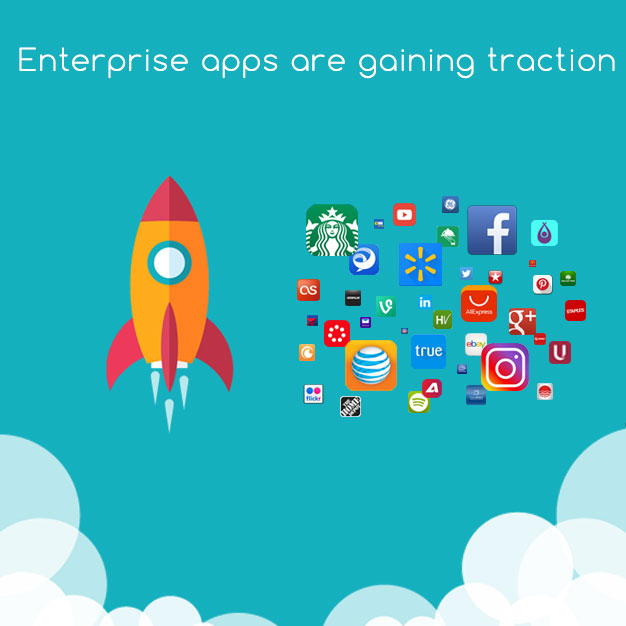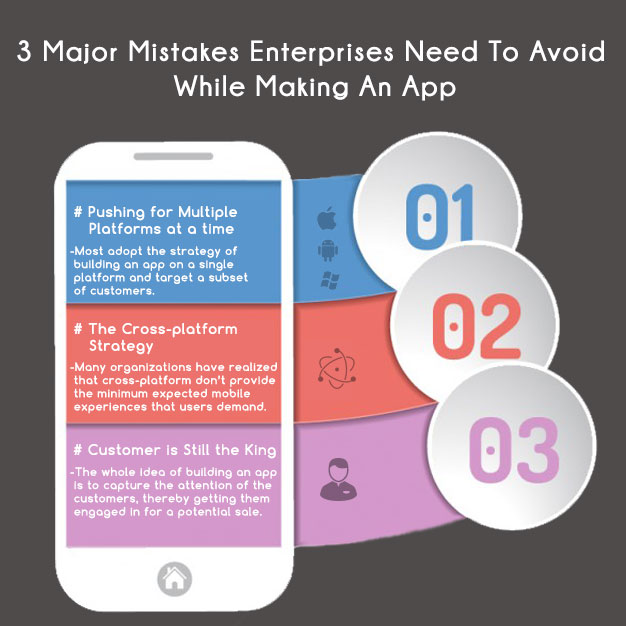3 Major Mistakes Enterprises Need To Avoid While Making An App
There are massive opportunities when it comes to mobile universe. With the internet becoming affordable, smartphones capabilities increasing and an exponential rise in smartphone users, mobile app connectivity is a huge market for enterprises. Mobile apps apart from providing a new front for customer engagement also help in increasing productivity and decreasing the otherwise needed efforts to attract and retain customers.
However, it seems many enterprises have not been able to effective use the mobile apps or perhaps efficiently use these apps for better customer engagement. Some met with failures while others did end with lower than expected results. While analyzing the different failures, we were able to identify three major mistakes which enterprises need to avoid while making a mobile app.
#1 Pushing for Multiple Platforms at a time
Many enterprises fail to remember that “Rome was not built in a single day”. It is a dream to have an app which will connect to every single customer out there in the market from the day one. However, the ground reality is totally different. In order to connect with every customer in the market, many would need to spend a big fortune, especially on the marketing side. Coming to the technical side, often apps targeting multiple platforms tend to fail the customers. Often there are potential mistakes and difficulties which could make the customers move elsewhere.
Most adopt the strategy of building an app on a single platform and target a subset of customers. Based on the feedback of the app and real-time analysis of customers, the app can be enhanced to be compatible on more platforms. This also helps in getting better and relevant feedback from customers. Moreover, this strategy helps in lowering the cost.
#2 The Cross-platform Strategy
Many enterprises look at the shortest route for building the customer base and many end up building a mobile app using cross-platform tools. Ironically, there are enterprises which believe the cross-platform app is the best strategy to serve multiple operating systems simultaneously. While there is nothing wrong in making use of cross-platform strategy, there is yet to be a single successful app that makes use of all technologies and deliver as expected.
For enterprises, it is often worth to build an app for multiple platforms. However, the apps developed comprises on user experience. Again, making use of third-party tools as a shortcut to building apps comes with a significant price, as enterprises would be dependent on third-party tools for all upgrades and updates.
There are many enterprises which learned all this in a hard way such as Facebook. Many organizations have now realized that hybrid applications or cross-platform toolkits do not provide the minimum expected mobile experiences that users demand. Remember, in today’s world, consumer expectations are skyrocketing. Consumers are well prepared with questions, suggestions and perhaps issues when it comes to a mobile app.
From a short-term perspective, some enterprises have saved costs by developing “once for all platforms”. However, on the long run, these organizations have incurred big expenses for redeveloping the app as a native application. All these come with the heavy impact on the brand’s credibility. Moreover, Mobile app developers/Mobile app development companies demand high investment when it comes to cross-platform app. There is an element of risk in such approaches.
The best practice here is to choose a platform which would be most comfortable for the customers. Once the app performs well and the brand has found the market fit, invest in building native apps across the platforms that could help generate revenue. Hence, it would be better to adopt the single platform app approach until the app receives a significant response for turning cross-platform.
#3 Customer is Still the King
One of the other big mistakes that enterprises make while building an app is by ignoring the customer. Many build an app focusing on their interests rather than that of the customers. This often results in developing an app which has lost features/capabilities that are invaluable to the customer.
The whole idea of building an app is to capture the attention of the customers, thereby getting them engaged in for a potential sale. Once engaged, customers would be more interested in looking at your brand or enterprise as that is what would be resonating in their minds most of the time. Many forget that the real power of a smartphone lies in the personal nature of the device. One an app is installed on a user’s smartphone; it is like having “you” all the time. This brings in an opportunity to connect with them and engage with them whenever and wherever.
So look at the key takeaways and build an app which is not only effective but also efficient in connecting with your products and services to the customers. And most importantly avoid these mistakes.
Still have your concerns?
Your concerns are legit, and we know how to deal with them. Hook us up for a discussion, no strings attached, and we will show how we can add value to your operations!


